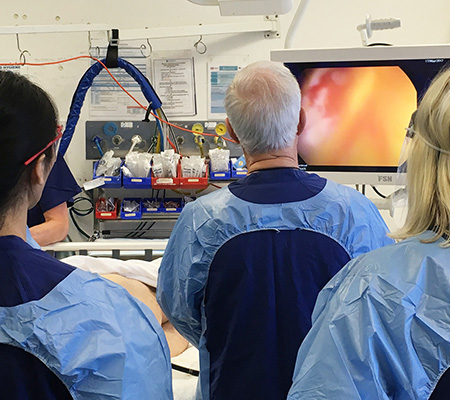Chemotherapy is a cancer treatment that uses drugs to stop the growth of cancer cells, either by killing the cells or by stopping them from dividing.
When chemotherapy is taken by mouth or injected into a vein or muscle, the drugs enter the bloodstream and can reach cancer cells throughout the body (systemic chemotherapy).
When chemotherapy is placed directly into the cerebrospinal fluid, an organ, or a body cavity such as the abdomen, the drugs mainly affect cancer cells in those areas (regional chemotherapy).
Chemoembolisation of the hepatic artery may be used to treat cancer that has spread to the liver. This involves blocking the hepatic artery (the main artery that supplies blood to the liver) and injecting anticancer drugs between the blockage and the liver.
The liver's arteries then deliver the drugs throughout the liver. Only a small amount of the drug reaches other parts of the body. The blockage may be temporary or permanent, depending on what is used to block the artery. The liver continues to receive some blood from the hepatic portal vein, which carries blood from the stomach and intestine.
The way the chemotherapy is given depends on the type and stage of the cancer being treated.

If your oncologist believes you will benefit from chemotherapy, they will discuss the best treatment plan options with you.
You may be prescribed one drug or a combination of drugs.
Depending on the stage of your bowel cancer, you may also be recommended treatment with targeted therapies.
The chemotherapy drugs approved by the Therapeutic Drugs Administration (TGA) in Australia for the treatment of bowel cancer are:
- 5-FU (5-fluorouracil)
- Capecitabine (Xeloda)
- Irinotecan (Camptosar)
- Lonsurf (Trifluridine and Tipircail)
- Oxaliplatin (Eloxatin)
- Raltitrexed (Tomudex)
-
FOLFOX (5-FU + leucovorin + oxaliplatin)
-
FOLFIRI (5-FU + leucovorin + irinotecan)
-
FOLFOXIRI (5-FU + leucovorin + oxaliplatin + irinotecan)
-
CAPOX or XELOX (capecitabine + oxaliplatin)
- CAPIRI or XELIRI (capecitabine + irinotecan)
Each drug has certain characteristic side-effects to be aware of. These side-effects can be 'risk assessed' for likelihood by your oncologist, and dosages can be altered to suit your own circumstances.
These standard drugs are considered to have a moderate risk for developing common side-effects associated with bowel cancer chemotherapy, including nausea and vomiting, diarrhoea and febrile neutropaenia (fever).
At what stage is this treatment used?
- At any stage of bowel cancer. It is usually combined with folinic acid (leucovorin calcium)
Is this drug available via the Pharmaceutical Benefits Scheme (PBS) as a subsidised treatment?
- Yes
- First-line therapy for patients with metastatic bowel cancer
- Treatment of patients with metastatic bowel cancer whose disease has recurred or progressed following initial therapy
Is this drug available via the Pharmaceutical Benefits Scheme (PBS) as a subsidised treatment?
- Yes
- Adjuvant treatment of stage III (Dukes C) colon cancer in combination with fluoropyrimidine agent
- In combination with fluorouracil and folinic acid for the treatment of metastatic bowel cancer
- In combination with capecitabine, with or without bevacizumab, for the treatment of patients with metastatic bowel cancer
Is this drug available via the Pharmaceutical Benefits Scheme (PBS) as a subsidised treatment?
- Yes
Download the Consumer Medicine Information (CMI) for Eloxatin.
| Lonsurf (Trifluridine and Tipiracil)
At what stage is this treatment used?
- Treatment of adult patients with metastatic bowel cancer (mCRC) who have been previously treated with, or are not considered candidates for fluoropyrimidine-, oxaliplatin- and irinotecan-based chemotherapies, anti-VEGF agents, and anti-EGFR agents
Is this drug available via the Pharmaceutical Benefits Scheme (PBS) as a subsidised treatment?
- Yes, subject to the following criteria:
- Initial treatment for patients with metastatic bowel cancer.
-
- Patient must have a WHO performance status of 1 or less;
AND
- Patient must have a WHO performance status of 1 or less;
-
- Patient must have previously received treatment with fluoropyrimidine, oxaliplatin, irinotecan-based chemotherapies, an anti-vascular endothelial growth factor (anti-VEGF) agent and an anti-epidermal growth factor receptor (anti-EGFR) agent for this condition; OR
-
- Patient must not be a suitable candidate for treatment with fluoropyrimidine, oxaliplatin, irinotecan-based chemotherapies, an anti-VEGF agent and an anti-EGFR agent for this condition;
AND
- Patient must not be a suitable candidate for treatment with fluoropyrimidine, oxaliplatin, irinotecan-based chemotherapies, an anti-VEGF agent and an anti-EGFR agent for this condition;
-
- The treatment must be the sole PBS-subsidised therapy for this condition.
- Continuing treatment for metastatic bowel cancer
-
- Patient must have previously been treated with PBS-subsidised treatment with this drug for this condition;
AND
- Patient must have previously been treated with PBS-subsidised treatment with this drug for this condition;
- Patient must not develop progressive disease whilst receiving PBS-subsidised treatment with this drug for this condition;
AND
- Patient must not develop progressive disease whilst receiving PBS-subsidised treatment with this drug for this condition;
- The treatment must be the sole PBS-subsidised therapy for this condition.
Download the Consumer Medicine Information (CMI) for Lonsurf.
At what stage is this treatment used?
- For use as a single agent in the palliative treatment of metastatic bowel cancer.
Is this drug available via the Pharmaceutical Benefits Scheme (PBS) as a subsidised treatment?
- Yes, however the treatment must only be used as a single agent in the treatment of metastatic bowel cancer.
Download the Consumer Medicine Information (CMI) for Tomudex.
- Adjuvant treatment of patients with stage III (Dukes C) and high risk Stage B colon cancer, either as a monotherapy or in combination with oxaliplatin.
- Treatment of patients with metastatic bowel cancer.
Is this drug available via the Pharmaceutical Benefits Scheme (PBS) as a subsidised treatment?
- Yes

How can I help manage chemotherapy induced nausea and vomiting?
- Avoid eating solid foods immediately before and after treatment
- Avoid caffeine and alcoholic drinks
- Drink clear liquids such as sports drinks, ginger ale, lemon-lime sodas, or dilute, unsweetened fruit juices
- Start with bland foods such as dry toast or crackers, then gradually increase to small, frequent meals throughout the day
- Avoid spicy or greasy foods
- Avoid favourite foods on days you are sick so they don't become nausea triggers
- Avoid strong smells that may upset your stomach such as cooking odours, smoke, or perfume
- Avoid lying flat for at least 2 hours following meals
- Contact your specialist team if vomiting is severe or if you cannot keep anything down
- Try doing some relaxing activities such as reading, puzzles, yoga, watching TV, or listening to music
- Alternative therapies such as selfhypnosis, guided imagery, progressive muscle relaxation or acupuncture
Side effects
Access
Who is most at risk?
In Australia there are a number of government bodies responsible for the regulation and availability of bowel cancer treatments.
The Therapeutic Goods Act 1989, regulations and orders, provide a national framework for the regulaton of therapeutic goods in Australia to ensure quality, safety and effectiveness of medicines. They also set out the requirements for inclusion of therapeutic goods in the Australian Register of Therapeutic Goods (ARTG), including advertising, labelling and product appearance, for example.
The Therapeutic Goods Administration (TGA) is a unit of the Australia Government Department of Health. It carries out a range of assessment and monitoring activities to ensure therapeutic goods available in Australia are of an acceptable standard. At the same time the TGA aims to ensure that the Australian community has access, within a reasonable time, to therapeutic advances.
All treatments used to prevent, cure or alleviate bowel cancer must be entered on the ARTG before they can be supplied in Australia. Once approved and entered on the ARTG, they are available for human use and can be accessed privately.
Some treatments can then be recommended by the Pharmaceutical Benefits Advisory Committee (PBAC) to be listed on the Pharmaceutical Benefits Scheme (PBS) as a subsidised treatment. The Scheme is available to all Australian residents who hold a current Medicare card.
The PBAC is an independent statutory body established to make recommendations and give advice to the Minister for Health about which treatments should be made available as pharmaceutical benefits.
No new treatment may be made available as a pharmaceutical benefit unless the Committee has so recommended.
The Committee is required by the National Health Act 1953 to consider the effectiveness and cost of a proposed benefit compared to alternative therapies. In making its recommendations the Committee, on the basis of community usage, recommends maximum quantities and repeats and may also recommend restrictions as to the indications where PBS subsidy is available.
When recommending listings, the Committee provides advice to the Pharmaceutical Benefits Pricing Authority (PBPA) regarding comparison with alternatives or their cost effectiveness.
Some treatments may not be recommended by the PBAC if they are deemed not cost-effective, even if they are clinically proven.
The issue of drug availability has received a lot of media attention and can be confusing and complicated. You should discuss all the options with your oncologist, and if a drug would be of benefit but it is not available via the PBS, you may consider accessing this privately or applying to a manufacturer to see if you are eligible to enter an access program or the drug made available on compassionate grounds. Also, ask about clinical trials.
A list of the applications for consideration at each PBAC meeting is published six weeks prior to each meeting. The sponsor of the submission will have already provided the PBAC with detailed clinical and economic data in support of the submission. However, you are welcome to provide comments from a personal (i.e. patient, carer, member of the public, health professional) or group perspective for consideration by the PBAC when the submission is considered.
Bowel Cancer Australia advocates for improved access to affordable treatment options and makes relevant submissions to the PBAC on behalf of bowel cancer patients. For more information on Bowel Cancer Australia's advocacy efforts and listing of new bowel cancer treatments, visit our access and wait times webpage.
Further details, including closing dates for submissions, can be found at the Pharmaceutical Benefits Advisory Committee webpage. The PBAC meets three times a year, usually in March, July and November.









